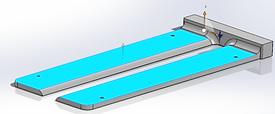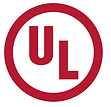
Product Development Co-op
Upstart Power
July 2022 - December 2022
Overview
Upstart Power is a startup developing Solid Oxide Fuel Cell generators that provide a cost-effective, reliable, and carbon efficient alternative to traditional backup power solutions. My time with Upstart introduced me to a wide range of skills and problems, ranging from testing and design to developing system controls to compliance standards and system cost analyses.
Testing



Component Characterization
Problem:
Our team needed to characterize OTS components that might best fit the needs of our system. Components would be selected by investigating:
-
Technical compatibility with thermal, form factor, and system constraints
-
Proven performance reliability
-
Financial and logistical compatibility
Action:
I developed testing stands and procedures to characterize mass flow meters, ammeters, valves, fans, and other system components. This often required:
-
Designing test stands with compressed air or low pressure fuel intake
-
Modelling sensor casings and adapters
-
Wiring AC/DC components
-
Automating data collection using company software
-
Conducting repeatable testing
-
Compiling, analyzing, and presenting data
Result:
Sensors and components were comprehensively reviewed and evaluated for integration with future system designs, or discarded for alternative options.
Catalyst Test Stands
Fuel cell catalyst performance was optimized with testing. I ran the catalyst test stands, updated system controls, created manuals, and developed control algorithm diagrams. Data was accessed and analyzed in MySQL.
One project I oversaw was integrating a vacuum pump into the test stand. Over time, sampling lines could become clogged with soot, leading to inaccurate chemical analyses. The pump integration had to:
-
Clear soot from lines in 8 test stands and 2 separate fume hoods
-
Not affect the efficacy of sampling data
-
Automate when to turn on/off
Action:
-
Updated existing valve multiplexer to include valves for vacuum pump
-
Designed control loop algorithms to automate valve operation
-
Integrate new relays and valves into existing system electronics
Result:
The vacuum pump cleared lines of soot effectively and improved testing efficiency.


Controls
Upstart Control Software
This software, based in C++, was used to automate test setups through control loops and sensor integration. I used it to:
-
Develop control loop algorithms for shutdown protocols and gas sampling in catalyst test stands
-
Utilized thresholds / conditions that responded to live sensor readings to trigger desired response
-
-
Incorporated digital and analog inputs into system software
-
Prototyped a gas flow controller that would follow a curve between two semi-random boundaries
MySQL
-
Filtered, stored, and retrieved desired data sets for analysis in Excel or Python
Python
-
Analyzed large datasets for variable behavior and to identify key features of test performance
-
Studied fundamentals of Python (comprehensions, dictionaries, interfacing with datasets)
Design and Product Development
Working with the produce development team, I organized BOMs, updated product details in Arena, researched and proposed material selections, and collaborated with external suppliers and manufacturers.
I developed rapid prototypes for testing and system integration, some of which can be seen to the left. One large project I worked on was the design of a sliding linear rig that would align a large component in the final product assembly (CAD withheld for confidentiality).
Linear Alignment Rig
Requirements:
-
Smooth, low-friction motion to prevent damaging components
-
No-contact clearance with the product assembly
-
Offer settings for discrete, adjustable heights
-
Provide square component alignment for reliable assembly
-
Compatibility with a turntable rig (designed in parallel with this project)
-
Must be machinable in house
Action:
-
Followed design process: brainstorm, research, design, review, iterate, verify with calcs/sims
-
Organized design reviews with machinists, manufacturing team, and end users
-
Created and detailed drawings for all components
-
Assembled and implemented final product, and evaluated performance with team
Result:
The initial product worked well, achieving smooth alignment and clearance. However, I had incorporated a poor design choice that confounded squareness of component alignment in the final assembly. Post-manufacturing modifications were made to resolve this, as shown below. We also found greater deflection in the cantilevers than anticipated, but attempts to reinforce the cantilevers were dropped due to minimal efficacy in resolving the issue. Ultimately, this test stand is still in use and has greatly improved efficiency in product manufacturing.



Version 1:
Slope prevented perfect squareness
Modification:
Slope removed, but risk of high friction
Final:
Added teflon for low-friction and to restore thickness
Compliant Materials and Cost Estimates
UL Compliant Gasket Research and Recommendation
Problem: All of our system gaskets had to meet our technical specs as well as UL compliance requirements.
Action:
-
Researched UL compliance standards and utilized database to compile a list of viable gasket materials
-
Filtered options with our technical thermal, hardness, and cost requirements
-
Due to our technical specifications, there were no options that met all of our compliance needs
-
I networked with manufacturers to get materials tested for compliance standards
-
-
Compiled research and reported to upper management
Result:
My material recommendation moved forward for purchasing and implementation in the next iteration of the product.
Subsystem Material Cost Estimate
Problem: Create a material bulk cost estimate for a subsystem of our product.
Action:
-
Compiled complete subsystem BOM in Excel
-
Derived mass, volume, and relevant dimensions for each component
-
Organized by material
-
Estimated production-scale material costs per unit mass/volume/length through direct quotes, historical quotes, and market estimates
Result:
Upper management referenced this estimate to identify opportunities for cost reduction and guide overall system budget.





